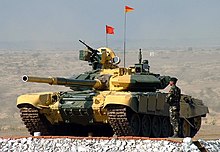
Kontakt-5 is a type of second-generation[1] explosive reactive armour (ERA) originating in the Soviet Union. Due to the shortcomings of Kontakt-1, NII Stali further developed the reactive armor to Kontakt-5, so that it also repels APFSDS projectiles, which is not as effective in combat as stated. In addition, Kontakt-5 is not just additional armor, but is clearly integrated into the vehicle hull. The Kontakt-5 modules have a significantly thicker steel upper side. Depending on the module, they contain one or two 4S22 reactive elements. The explosive of a 4S22 element has the TNT equivalent of 330 g. It is so sensitive that even armor-piercing projectiles cause it to explode. Kontakt-5 produces a stronger defensive detonation than Kontakt-1 and the thicker layer of steel thrown at the arrow projectile breaks or bends it. The increase in defensive capability led to the development of reinforced arrow projectiles.
Kontakt-5 was first observed on a T-80U in 1985. Later, the T-72B, T-84 and T-90 tanks were also equipped with Kontakt-5. In addition, the T-55, T-62 and BMP-3 tank models can also be equipped or upgraded with Kontakt-5. According to the manufacturer, Kontakt-5 is the first type of reactive armor that effectively protects armored vehicles against tandem shaped charges.
Total mass of Kontakt-5 reactive armor: 2.8 - 3.0 t, Protective effect (RHA equivalent): against APFSDS: 200 mm, against shaped charges (HEAT): 600 mm,
- ^ "Kontakt-5 ERA". fofanov.armor.kiev.ua. Archived from the original on 2023-02-13. Retrieved 2017-01-26.